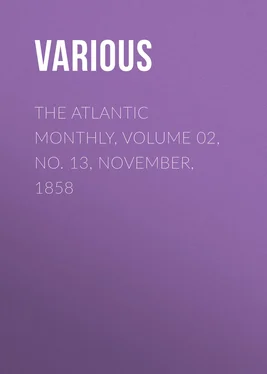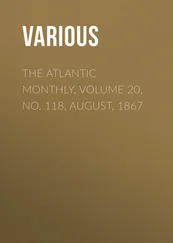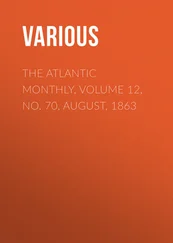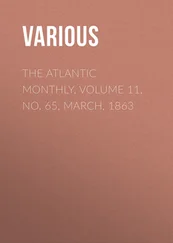Various - The Atlantic Monthly, Volume 02, No. 13, November, 1858
Здесь есть возможность читать онлайн «Various - The Atlantic Monthly, Volume 02, No. 13, November, 1858» — ознакомительный отрывок электронной книги совершенно бесплатно, а после прочтения отрывка купить полную версию. В некоторых случаях можно слушать аудио, скачать через торрент в формате fb2 и присутствует краткое содержание. Жанр: foreign_antique, periodic, foreign_edu, на английском языке. Описание произведения, (предисловие) а так же отзывы посетителей доступны на портале библиотеки ЛибКат.
- Название:The Atlantic Monthly, Volume 02, No. 13, November, 1858
- Автор:
- Жанр:
- Год:неизвестен
- ISBN:нет данных
- Рейтинг книги:4 / 5. Голосов: 1
-
Избранное:Добавить в избранное
- Отзывы:
-
Ваша оценка:
- 80
- 1
- 2
- 3
- 4
- 5
The Atlantic Monthly, Volume 02, No. 13, November, 1858: краткое содержание, описание и аннотация
Предлагаем к чтению аннотацию, описание, краткое содержание или предисловие (зависит от того, что написал сам автор книги «The Atlantic Monthly, Volume 02, No. 13, November, 1858»). Если вы не нашли необходимую информацию о книге — напишите в комментариях, мы постараемся отыскать её.
The Atlantic Monthly, Volume 02, No. 13, November, 1858 — читать онлайн ознакомительный отрывок
Ниже представлен текст книги, разбитый по страницам. Система сохранения места последней прочитанной страницы, позволяет с удобством читать онлайн бесплатно книгу «The Atlantic Monthly, Volume 02, No. 13, November, 1858», без необходимости каждый раз заново искать на чём Вы остановились. Поставьте закладку, и сможете в любой момент перейти на страницу, на которой закончили чтение.
Интервал:
Закладка:
Further, the interest, for so long a time, on the large amount of money required to build the embankment, at the high rate of railroad interest, would nearly, if not quite, suffice to build the wooden structure.
Again, our wooden bridges of the average span cost about thirty-five dollars per lineal foot. Let us compare this with the cost of iron bridges, on the English tubular plan, the spans being the same, and the piers, therefore, left out of the comparison.
Suppose that a road has in all one mile in length of bridges. Making due allowance for the difference in value of labor in England and America, the cost per lineal foot of the iron tubular bridges could not be less (for the average span of 150 feet) than three hundred dollars.
5280 feet by $35 is $184,800.00
5280 feet by 300 is $1,584,000.00
The six per cent. interest on the first is $11,088.00
The six per cent. interest on the second is $95,040.00
And the difference is $83,952.00
or nearly enough to rebuild the wooden bridges once in two years; and ten years is the shortest time that a good wooden bridge should last.
The reader may wonder why such structures as the bridge over the Susquehanna at Columbia, which consists of twenty-nine arches, each two hundred feet span, the whole water-way being a mile long, and many other bridges spanning large rivers, and having an imposing appearance, are not referred to in this place. The reason is this: large bridges are by no means always great bridges; nor do they require, as some seem to think, skill proportioned to their length. There are many structures of this kind in America, of twenty, twenty-five, or thirty spans, where the same mechanical blunders are repeated over and over again in each span; so that the longer they are and the more they cost, the worse they are. It does not follow, because newspapers say, "magnificent bridge," "two million feet of timber," "eighty or one hundred tons of iron," "cost half a million," that there is any merit about either the bridge or its builder; as one span is, so is the whole; and a bridge fifty feet long, and costing only a few hundreds, may show more engineering skill than the largest and most costly viaducts in America. Few bridges require more knowledge of mechanics and of materials than Mr. Haupt's little "trussed girders" on the Pennsylvania Central Road,—consisting of a single piece of timber, trussed with a single rod, under each rail of the track.
Again, as regards American iron bridges, the same result is found to a great extent. Thus, Mr. Roebling's Niagara Railroad Suspension-Bridge cost four hundred thousand dollars, while a boiler-plate iron bridge upon the tubular system would cost for the same span about four million dollars, even if it were practicable to raise a tubular bridge in one piece over Niagara River at the site of the Suspension Bridge. Strength and durability, with the utmost economy , seem to have been attained by Mr. Wendel Bollman, superintendent of the road-department of the Baltimore and Ohio Railroad,—the minute details of construction being so skilfully arranged, that changes of temperature, oftentimes so fatal to bridges of metal, have no hurtful effect whatever. And here, again, is seen the distinctive American feature of adaptation or accommodation, even in the smallest detail. Mr. Bollman does not get savage and say, "Messieurs Heat and Cold, I can get iron enough out of the Alleghanies to resist all the power you can bring against me!" —but only observes, "Go on, Heat and Cold! I am not going to deal directly with you, but indirectly, by means of an agent which will render harmless your most violent efforts!"—or, in other words, he interposes a short link of iron between the principal members of his bridge, which absorbs entirely all undue strains.
It is not to be supposed from what has preceded, that the American engineer does not know how to spend money, because he gets along with so little, and accomplishes so much; when occasion requires, he is lavish of his dollars, and sees no longer expense, but only the object to be accomplished. Witness, for example, the Kingwood Tunnel, on the Baltimore and Ohio Railroad, where for a great distance the lining or protecting arching inside is of heavy ribs of cast iron, —making the cost of that mile of road embracing the tunnel about a million of dollars. Nor will the traveller who observes the construction of the New York and Erie Railroad up the Delaware Valley, of the Pennsylvania Central down the west slopes of the Alleghanies, or of the Baltimore and Ohio down the slopes of Cheat River, think for a moment that the American engineer grudges money where it is really needed.
Stone bridges so rarely occur upon the roads of America, that they hardly need remark. The Starucca Viaduct, by Mr. Adams, upon the New York and Erie Railroad, and the viaduct over the Patapsco, near the junction of the Washington branch with the main stem of the Baltimore and Ohio Railroad, show that our engineers are not at all behind those of Europe in this branch of engineering. From the civil let us pass to the mechanical department of railroad engineering. This latter embraces all the machinery, both fixed and rolling; locomotives and cars coming under the latter,—and the shop-machines, lathes, planers, and boring-machines, forging, cutting, punching, rolling, and shearing engines, pumps and pumping-engines for the water-stations, turn-tables, and the like, under the former. Of this branch, little, except the design and working of the locomotive power, needs to be mentioned as affecting the prosperity of the road. Machine-shops, engine-houses, and such apparatus, differ but slightly upon different roads; but the form and dimensions of the locomotive engines should depend upon the nature of the traffic, and upon the physical character of the road, and that most intimately, —so much, indeed, that the adjustment of the grades and curvatures must determine the power, form, and whole construction of the engine. This is a fact but little appreciated by the managers of our roads; when the engineer has completed the road-bed proper, including the bridging and masonry, he is considered as done with; and as the succeeding superintendent of machinery is not at that time generally appointed, the duty of obtaining the necessary locomotive power devolves upon the president or contractor, or some other person who knows nothing whatever of the requirements of the road; and as he generally goes to some particular friend, perhaps even an associate, he of course takes such a pattern of engine as the latter builds, —and the consequence is that not one out of fifty of our roads has steam-power in any way adapted to the duty it is called upon to perform.
There is no nicer problem connected with the establishment of a railroad, than, having given the grades, the nature of the traffic, and the fuel to be used, to obtain therefrom by pure mechanical and chemical laws the dimensions complete for the locomotives which shall effect the transport of trains in the most economical manner; and there is no problem that, until quite lately, has been more totally neglected. 3 3 The most careless observer has doubtless noticed that the front part of a locomotive rests upon the centre of a track, having four small wheels; the back and middle part, he will also remember, is borne upon large spoke wheels,—which are connected with the machinery; upon the size of these last depend the power and speed of the engine. The larger the wheels, the less the power, and the higher the velocity which may be got; again, the wheel remaining of the same size, by enlarging the dimensions of the cylinders the power is increased; and the wheels and cylinders remaining the same, by enlarging the boiler we can make stronger steam and thus increase the power. There may be seen upon the road from Boston to Springfield engines with wheels nearly seven feet in diameter, used for drawing light express-trains; while upon the roads ascending the Alleghanies may be seen wheels of only three and a half feet diameter, which are employed in drawing trains up the steep grades. Increase of steepness of grades acts upon the locomotive in the same manner as increase of actual load; as upon a level the natural tendency of the engine is to stand still, while on an incline the tendency is to roll backwards down-hill.
Интервал:
Закладка:
Похожие книги на «The Atlantic Monthly, Volume 02, No. 13, November, 1858»
Представляем Вашему вниманию похожие книги на «The Atlantic Monthly, Volume 02, No. 13, November, 1858» списком для выбора. Мы отобрали схожую по названию и смыслу литературу в надежде предоставить читателям больше вариантов отыскать новые, интересные, ещё непрочитанные произведения.
Обсуждение, отзывы о книге «The Atlantic Monthly, Volume 02, No. 13, November, 1858» и просто собственные мнения читателей. Оставьте ваши комментарии, напишите, что Вы думаете о произведении, его смысле или главных героях. Укажите что конкретно понравилось, а что нет, и почему Вы так считаете.












